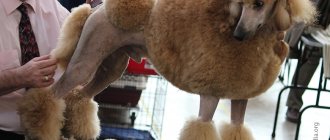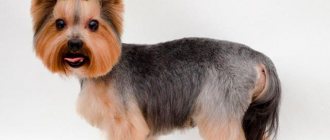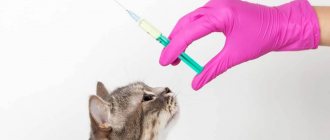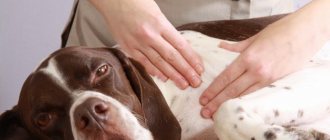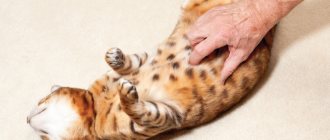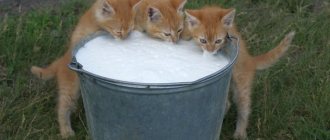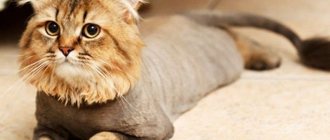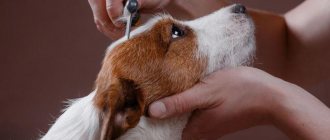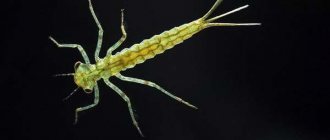After grooming, the Scottish cat needs to be washed again with shampoo. This will remove cut hairs and wash out the bottom layer of fur that may not have been completely cleaned during the first bath.
Grooming a cat is a rather labor-intensive and complex process, since most pets do not tolerate such procedures well. Therefore, unless absolutely necessary, you should not subject the animal to such a test. And if the owner is not confident in his skills, then it is better to seek help from professionals.
Do Scottish Fold cats need to be cut?
Grooming a Scottish cat is not the most popular procedure; most often the hair is shortened as needed, for example, before medical procedures or if the pet is very dirty. Some owners prefer to groom their cats before shows and for photo shoots.
Important! If a Scot is getting his hair cut for the first time, then it should be done by a specialist. Then the cat will receive minimal psychological stress, and the owner will become familiar with the procedure and will be able to repeat them on his own in the future.
Reasons for haircut
The most common reasons that prompt an owner to cut a Scottish cat's hair are:
- Formation of tangles and unkempt appearance of the coat. This applies to long-haired Highland Folds that are poorly groomed.
- Excessive and prolonged shedding - during this period, Scottish cats are cut to get rid of excessive amounts of hair on carpets and sofas.
- Skin diseases. More often they arise due to poor care of the Scots, but sometimes they also appear for reasons beyond the control of the owners.
- Formation of hairballs in the stomach (trichobezoars).
The thick undercoat forms a dense “felt” layer, does not allow air to pass through and creates comfortable conditions for the proliferation of skin parasites. Unlike tangles, which you can try to comb out, here cutting is the only rational solution.
Scottish Straight character
It would be a big mistake to label all Scottish Straights as phlegmatic philosophers. Moreover, among these imposing cats, sometimes there are real livelies who love to chase a wind-up mouse and measure their strength with the owner. And yet, for the most part, Scottish straight cats do not have a violent temperament. Proud and serious, they cannot stand total control and are unlikely to allow themselves to be squeezed into a semi-conscious state. This, of course, does not make Scottish ascetics and sad hermits, they just require a little more independence and personal space than representatives of other breeds. Straights prefer to spend their free time in peace and quiet, lounging on the couch and learning Zen in the Buddha pose.
Squeezing the cat
The Scots are happy to make contact and join in the games, but only when they want to. In all other cases, it is better to leave the cat alone. The peak of motor activity of straight-eared Scottish cats occurs in the first year of their life. By the way, Scottish babies in their playfulness and restlessness are practically no different from ordinary outbred kittens. Adults, on the contrary, are famous for their exemplary behavior and patience. If you go on a visit for a couple of hours, leaving the Straight alone, he will easily survive it. However, weeks of loneliness, interrupted by rare raids from the owner, will not improve the character of the animal. As for the pacifying purr of straight-eared Scottish cats, it still needs to be earned: cats purr infrequently, and meow only in exceptional, from their own point of view, cases. Scottish Straights accept strangers and noisy groups of guests in a completely “secular” way, which means without unnecessary suspicion and aggression, but also without wild delight.
Scottish Straight cats are emotionally stable and not subject to sudden mood swings. However, exceptions to the general rule have not been canceled, so amateur videos with catchy headlines like: “The most disgruntled Scottish in the world” periodically appear on the Internet. In addition, straights are characterized by amazing persistence. If a cat wants something, he will definitely achieve it, following on the heels of the owner, and sometimes reinforcing his actions with annoying meows.
How to cut your hair at home
Tools and accessories
You can only trim a very calm cat at home, and if it is already accustomed to such a procedure. The easiest option is to trim the fur with a machine with one attachment. Every owner should have the simplest skills necessary for grooming a pet. In hot weather, a short hairstyle can save your long-haired pet from heatstroke.
You will find most of the cutting equipment at home. The procedure can be done on a table, covered with a sheet, or on an ironing board. In the latter case, the “stand” must be stable. Scissors - simple and thinning - will also come in handy. Hair clippers are also often found in homes. If not, you can purchase it at the store. It should be comfortable and have various attachments. You cannot do without it when performing the procedure. Also purchase three percent hydrogen peroxide and cotton wool. Your pet should also have a comb-comb.
A minimum of two people will be needed to perform the procedure. It is better if the helpers know how to handle cats.
What harm can a haircut cause?
The negative consequences of grooming in Scottish cats include both physiological and psychological factors:
- If there are other cats in the house, the short-haired Scottish Fold will most likely lose authority in the family hierarchy of four-legged pets. He will have to re-prove his right to a “place in the sun.”
- It has been noticed that after a haircut, which is a serious psychological stress, pampered lop-eared Scots very slowly return to normal.
- Damage to the whiskers during the cutting process. Sensitive hairs grow throughout the cat's body and help her navigate in space. Therefore, after the procedure, the animal may sway slightly when moving, but this quickly passes.
- Skin deprived of hair becomes chapped, peels and dries out. Additional care will be required to keep your Scots skin healthy until the new coat begins to protect it from the elements.
- It will take time for the fur to recover after shearing. The fact is that under natural conditions, hair does not change simultaneously, but is renewed gradually. Mechanical hair removal disrupts this process. Therefore, the new coat will be slightly worse than the previous one.
Most often, Scottish cats are cut on the recommendation of a veterinarian.
Grooming
Once or twice a week you need to comb the British coat with a medium-frequency metal comb and a massage brush with natural bristles. First with the growth of the fur, and then against the grain. You should start from the pet's back, then scratch along the sides, moving to the chest. The cheeks and neck are combed towards the cat's face. After the combing procedure, all excess hair is removed using a rubber mitten or wet palms.
Is it necessary to cut a British cat's haircut?
For your information! It is recommended to finish this procedure by applying a protein conditioner or anti-shedding spray to the combed coat. Such products can improve the structure of the coat and maintain a healthy shine.
About once every three weeks, it is recommended to clean the coat with dry shampoo or powder, which is massaged into the coat and then thoroughly combed out with a brush. Such products contain silicone and special components that cleanse the coat of subcutaneous fat and dirt, remove static electricity and add volume.
Once every three months it is necessary to bathe the cat using high-quality shampoo, which contains lecithin, conditioner and antistatic components. After washing, dry the coat thoroughly using several towels and, if the cat is not afraid, a hair dryer, and then comb thoroughly.
Combing out the excess hair of the “British” should be done 2 times a week.
Combing allows you to get rid of excess falling hairs, which, during the licking process, end up in the “British”’s gastrointestinal tract. A hairball can lead to a blockage in the stomach and intestinal obstruction, causing the cat to suffer from lack of appetite, constipation and vomiting. Trying to avoid such problems, owners are thinking about grooming British cats.
Types of haircuts
There are different ways to cut a Scottish cat's hair. However, two models have already become traditional for all cats:
- Haircut “like a lion” - the head and mane to the shoulder blades, paws and the tassel at the tip of the tail remain untouched.
- “Puss in Boots” haircut – from the neck the body is machined, at the end of the legs neat boots of arbitrary height are made and a tassel is always left on the tail.
- “Like a dinosaur” - the head and paws of a Scottish cat are cut “like a lion”, but a jagged ridge of wool is formed along the spine.
- Cat in a skirt - haircut for girls. A fluffy hem is left on the body just below the line where the ribs end, and the rest of the hair is shaved.
This is interesting! Recently, a new fashion trend has emerged - applying colored patterns to wool. You need to use only high-quality paints that are safe for your pet’s health.
Why groom cats?
Typically, cats are clipped for two reasons. The first is to take care of the pet’s health, and the second is to add attractiveness. Regarding health status, there are medical indications for grooming:
- skin diseases;
- infestation with ticks and fleas;
- hyperplasia.
In all these cases, the skin should be treated with medications and haircuts cannot be avoided. Also, with age, it is difficult for elderly pets to keep their fur coat in good condition, so by trimming the fur, the owner makes it easier for himself to care for his pet.
There are also cases when an animal was picked up on the street, and the cat looks unsightly: tangled fur, pellets and “icicles.” The only way to help your pet and bring it back to normal is to trim its fur. But it will be difficult to manage on your own.
Scissors should not be allowed in as they can damage the skin. It is also unlikely that you will be able to comb matted fur. Bathing is problematic, since tangles take a long time to dry and can lead to inflammation. The only way out is to shave your pet and continue to provide careful care. You should shave with a clipper carefully, holding the skin so as not to injure the little one.
How often can you groom an animal?
The regularity of haircuts depends on 2 factors: the cat’s reaction and possible consequences for its health. If the first haircut provoked long-term stress or lowered the status of the animal among other four-legged animals, then in the future it is worth abandoning such procedures.
You also need to pay attention to how the haircut affected the structure and color of the coat.
Before grooming your pet, it is advisable to seek advice from a professional groomer or veterinarian.
Important! Shorthaired Scottish Fold Fold cats are groomed no more than once a year. Longhaired Highlands will take even longer to fully recover from the first treatment.
Education and training
Fold cats are very smart and easy to train. Teaching your pet basic skills is not difficult.
It is advisable to accustom your cat to order and discipline from an early age. To accustom a kitten to the tray, it is enough to often play with it not far from the tray and, if necessary, immediately put it there.
Soon he will remember where to relieve himself.
Teach your fold cat to listen to its owner and understand the command “No!” You can use a regular baby rattle.
It is enough to simply rattle it loudly over his ears and loudly say “No!” when he does something forbidden (for example, tries to climb on the table or starts scratching the furniture).
Folds are very sensitive to loud sounds at an early age, so training using similar methods gives results. It is not recommended to physically punish a kitten, as in the future it may stop trusting its owner and be afraid of him.
For good behavior and obedience, the pet must be praised and rewarded with some kind of treat.
Scottish Folds very quickly get used to the house and the owner. Despite their independence, they still require at least a little attention.
If the owner is often not at home, the kitten may start meowing in the middle of the night, thereby attracting attention to itself.
To prevent this from happening, you need to devote at least 10-20 minutes of time to it before going to bed. They rarely spoil things and almost never jump on furniture and curtains.
If your pet is left alone in the apartment for a long time, it is enough to leave him a few toys, such as balls or a rubber mouse. In this case, the pet will not be bored for a long time, and will have something to do in the absence of the owner.
Why do you need a cat grooming?
The main purpose of grooming is to take care of the condition of the cat's coat. It is in the nature of the cat breed to take care of its fur. But often the efforts of pets alone are not enough, this is especially true for cats whose fur exceeds 3 cm. Those with long coats are recommended additional care, which includes daily combing, removing tangles, and cutting off excess hair.
There are two types of zoo clipping:
- Hygienic.
- Model (exhibition).
What owners should know
Model or hygienic grooming of cats is a safe and useful procedure, but there are cautions and contraindications for its implementation. It is best for owners to be aware of the possible adverse effects before trimming their pet. Many owners follow fashion trends without thinking about how their four-legged friend will react to all sorts of innovations.
- Visiting a grooming salon and contact with strangers is a huge stress for a cat. If there is no urgent need due to current molting, urgent preparation for an exhibition, the presence of a large number of tangles, or treatment of skin pathologies, then it is better to refrain from testing the pet’s nerves. Depending on the animal's temperament, groomers may use a partner to restrain the animal or administer sedation.
- There is no need to overestimate your abilities and try to remove fur from the skin of your furry four-legged friend yourself. It must be borne in mind that household scissors and clippers for cutting human hair are not suitable for such purposes. In any case, this cannot be done without outside help due to the fact that most animals are reluctant to allow their fur to be manipulated. The most harmless thing that can happen if domestic cats are groomed in an artisanal way is a spoiled appearance. But the worst thing is that you can injure the animal or get severe scratches from it.
- If your four-legged pet is not a sociable member of the cat family, so as not to have to use anesthesia, it is better to trim the cat at home using the service of a groomer. In a home environment, the cat feels in its territory and its behavior will be calmer.
- Long-haired cats should be groomed 2 or 3 times a year. The frequency of hairdressing procedures depends on the initial length, intensity of hair growth, and the health status of the pet.
- A few days before the hairdressing procedures, the cat will need to shorten its claws to prevent injury to the master, his assistants and the animal itself.
- It is strictly forbidden to cut the hair on the cat's head, shorten the mustache, eyebrows, or hairs in the ears. The tail must also be treated with extreme care; long hairs can be cut off from this area, but completely shaving off the fur is not recommended.
- It is necessary to take into account the fact that in some cats, after hairdressing manipulations, the fur changes its structure, the hairs become thinner or thicker or change color.
- From practice, there are cases when the fur of cats grows back to its original length over a long period of time or completely stops growing.
This is interesting: Where can you go without a visa?
Technique of the procedure
Before grooming Scottish Folds, it is recommended to trim their nails. You can also use thick wristbands to protect your wrists from scratches.
The procedure is carried out in several stages:
- Apply a degreasing composition to dry wool and rub it well along the entire length of the hair. In longhaired Scots, special attention is paid to the tail, hind legs and collar area. To the rest of the body (including the head), the drug is usually applied without much effort.
- After the period of time specified by the manufacturer, the product is washed off with water.
- Apply the main shampoo, rub it with your hand until foam forms and after 2-3 minutes rinse thoroughly. The procedure can be repeated several times (depending on the degree of contamination of the wool).
- The final stage is treatment with conditioner, which gives the wool shine, silkiness and covers it with a protective layer.
- After bathing, the Scottish cat is wrapped in a towel and the coat is dried.
- The haircut is performed using a special electric clipper, but in the groin area and under the tail, the hair is carefully removed with ordinary scissors.
- Scissors are also used to form curly elements of the hairstyle and trim.
After grooming, the Scottish cat needs to be washed again with shampoo. This will remove cut hairs and wash out the bottom layer of fur that may not have been completely cleaned during the first bath.
Grooming a cat is a rather labor-intensive and complex process, since most pets do not tolerate such procedures well. Therefore, unless absolutely necessary, you should not subject the animal to such a test. And if the owner is not confident in his skills, then it is better to seek help from professionals.
What should you know about grooming?
Grooming cats is a complex process with many nuances.
- Under no circumstances should you cut your head, ears or whiskers: there is a risk of damaging the whiskers.
- Don't cut your tail bald: most cats try to chew it and cause serious wounds to themselves. Keep hair on at least one third of the tail.
- The same applies to the paws: it is imperative to leave “toes” in the area of the toes and the lower joint of the paw. But their length may vary.
- After shortening, the color of the coat may change dramatically.
- It is better not to cut animals with color point or tipping color at all: after this, the coat will sharply darken.
- The ideal length of shortened wool is 3 mm. It feels like velor fabric or plush to the touch, does not prick and does not cause discomfort to the animal. If you cut with a 1 mm nozzle, then the first week the hairs will be very stiff and only then will they acquire their usual softness.
- Don't cut your cat's hair. The skin of these animals is very delicate and can easily burn even in not too hot sun. In addition, the fur reliably protects them during play, and a hairless cat can seriously be scratched simply by scratching.
- Tangles can only be removed using a machine. Scissors should be used only as a last resort and with extreme caution. To do this, a fine comb is threaded under the mat, and the wool is carefully cut over it.
- If you are preparing for an exhibition, take care to do your pet's hair no later than six months in advance. Then it can be corrected a little.

